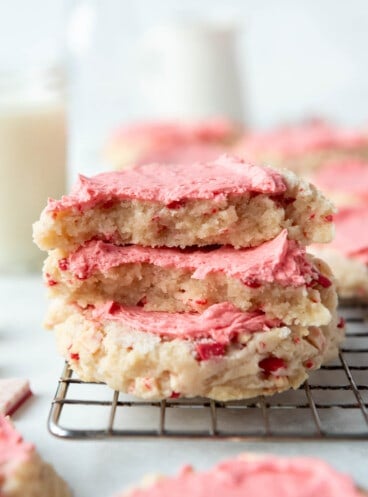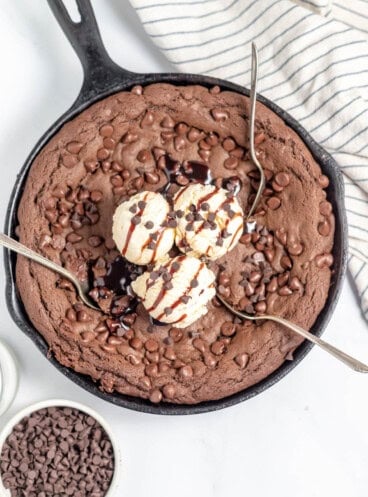Joe Froggers Cookies are soft, oversized molasses cookies flavored with rum (or rum extract in this case) dating back to the Revolutionary War when they were created in Marblehead, Massachusetts. A true American original and perfect for the 4th of July!

We love old-fashioned cookie recipes! Some of our other favorites are Lime Meltaway Shortbread Cookies, Oatmeal Fudge Bars, and Oatmeal Rolled Sugar Cookies.
Joe Froggers Cookies
Last 4th of July, my family visited the Colonial Fest in Orem, Utah, which is part of the area’s larger Freedom Festival celebration. As part of the festival, there are demonstrations and reenactments of colonial life, including debates, storytelling, and “citizens” being mustered into the colonial army.
We loved getting our silhouettes made right in front of us by an artist who used tiny scissors to create incredible renditions of each of our profiles. But we especially liked the booth that sold baked goods from the Revolutionary War era, including these Joe Froggers cookies. With Independence Day just around the corner, my blogging friend Jenni, from The Gingered Whisk, and I decided to share recipes popular during the Revolutionary War for our next installment in the Historically Hungry series.

Joe Froggers History
While waiting for our Joe Froggers at the colonial fest, I learned a little about the history of these molasses-spice cookies that I have since learned may or may not be entirely accurate, although it makes for a fun story, regardless of whether it is fact or merely legend.
As it goes, there was a free African American man named Joseph Brown who ran a tavern (possibly called Black Joe’s Tavern) with his wife, Lucretia, in Marblehead, Massachusetts. The tavern was located next to a frog-filled pond, and popular amongst the sailors and fishermen who would visit the town. Supposedly, Lucretia decided to make the cookies extra large – the size of the lilypads in the pond – hence the name “froggers”.
The soft, sweet, chewy cookies stayed that way–soft, sweet, and chewy–for a long time without going stale, thanks, perhaps, to the molasses, rum, and lack of eggs, that are the signature hallmarks of a Joe Frogger cookie. And they were made large – about 6 inches in diameter or the size of a salad plate. Apparently, the fishermen and sailors loved taking a treat with them out to sea that wouldn’t go bad quickly so they could have something sweet to eat.
Although no one is quite certain of the exact original recipe, very little has likely changed over the years, with the notable exception of eliminating “seawater”, which I saw mentioned as a possible original ingredient by at least one source. But essentially, the recipe is based on a standard gingerbread or molasses cookie recipe: flour, sugar, butter, molasses, and spices. It’s an egg-free recipe, just in case anyone is wondering if they were left out of the recipe by accident.

How to Make Joe Froggers Cookies
- Stir the molasses, hot water, and rum extract together in a bowl.
- In a separate bowl, whisk together the flour, baking soda, salt, and spices.
- In the bowl of a stand mixer, cream the butter and sugar until light and fluffy (about 3-4 minutes).
- Alternate adding part of the flour mixture, then part of the molasses mixture, and mixing between additions, scraping down the sides of the bowl as needed.
- Make two discs of dough and wrap them in plastic wrap, then refrigerate for at least two hours.
- When the dough is chilled, preheat the oven to 375°F and line a couple of cookie sheets with parchment paper.
- Roll out the chilled dough on a lightly floured surface to ¼ inch thickness, then cut into large circles using the lid of a coffee can (or in my case, the lid from the large jar of animal crackers from Costco). Any large lid would work, really, as long as it is about 6-inches in diameter or roughly the size of your hand. Although you could make the cookies smaller if you really wanted to.
- Transfer the cut-out cookies to the cookie sheets, leaving at least an inch between cookies (I can only bake 4 per pan). Bake for 8-10 minutes just until the edges begin to brown. The cookies should be soft in the middle since they will continue to harden as they cool. Cool completely on a wire rack.
Recipe Tips
- I wouldn’t try to make these by hand. A stand mixer with a paddle attachment makes it so much easier.
- You could use real rum if you have it on hand. Other recipes I saw called for 3 ½ tablespoons of rum. I used 1 teaspoon of rum extract, instead, which I always have on hand because I use it for things like homemade eggnog (another historically hungry post!).
- The dough is pretty sticky, which is why it needs to be refrigerated for at least 2 hours, or even overnight.
- Only work with one disc of dough at a time and leave the other in the fridge so it stays cold.
- If you cook your Joe Froggers a little too long and they get harder than you would like, no worries–these cookies are perfect for dunking in milk! Although you have to break them into pieces to get them to fit into the glass.

More Old-Fashioned Cookie Recipes
- Soft & Chewy Molasses Cookies
- Oatmeal Rolled Sugar Cookies
- The Best Snickerdoodle Cookies Recipe
- Best Cut-Out Sugar Cookies
- Soft & Chewy Gingerbread Men Cookies
Did you make this recipe?
Let me know what you thought with a comment and rating below. You can also take a picture and tag me on Instagram @houseofnasheats or share it on the Pinterest pin so I can see.
Joe Froggers Cookies
Ingredients
- 1/3 cup hot water
- 1 cup unsulphured dark molasses
- 1 teaspoon rum extract
- 3 1/2 cups all-purpose flour
- 1 1/2 teaspoons salt
- 1 teaspoon baking soda
- 1 1/4 teaspoons ground ginger
- 1/2 teaspoon ground cloves
- 1/2 teaspoon ground allspice
- 1/4 teaspoon ground nutmeg
- 1/2 cup salted butter softened
- 1 cup granulated sugar
Instructions
- Stir the molasses, hot water, and rum extract together in a bowl.⅓ cup hot water, 1 cup unsulphured dark molasses, 1 teaspoon rum extract
- In another bowl, whisk together the flour, baking soda, salt, and spices.3 ½ cups all-purpose flour, 1 ½ teaspoons salt, 1 teaspoon baking soda, 1 ¼ teaspoons ground ginger, ½ teaspoon ground cloves, ½ teaspoon ground allspice, ¼ teaspoon ground nutmeg
- In the bowl of a stand mixer, cream the butter and sugar until light and fluffy (about 3-4 minutes).½ cup salted butter, 1 cup granulated sugar
- Alternate adding part of the flour mixture, then part of the molasses mixture, and mixing between additions, scraping down the sides of the bowl as needed.
- Make two discs of dough and wrap them in plastic wrap, then refrigerate for at least two hours.
- When the dough is chilled, preheat the oven to 375°F and line a couple of cookie sheets with parchment paper.
- Roll out the chilled dough on a lightly floured surface to ¼ inch thickness, then cut into large circles using the lid of a coffee can (or in my case, the lid from the large jar of animal crackers from Costco). Any large lid would work, really, as long as it is about 6-inches in diameter or roughly the size of your hand. Although you could make the cookies smaller if you really wanted to.
- Transfer the cut-out cookies to the cookie sheets, leaving at least an inch between cookies (I can only bake 4 per pan). Bake for 8-10 minutes just until the edges begin to brown. The cookies should be soft in the middle since they will continue to harden as they cool. Cool completely on a wire rack.
Notes
Nutrition
Also, be sure to check out Jenni’s Historically Hungry Revolutionary War recipe–George Washington’s Carrot Tea Cake.






I love this historically hungry recipe series and this cookie recipe is great!
Um, I might have eaten the whole batch! Molasses + rum? Pure heaven!
Wow. I haven’t baked these yet, but I feel like the flour ratio is way off. I typically use my grandmothers recipe, which calls for 5 c flour. However, I didn’t have access to it today. This was more like batter than dough. I had to alter it and add at least another cup of flour, and it probably could have used more. Do you typically make these from a batter, rather than a dough?
No, it should definitely be a dough. Sounds like maybe there was a problem with measuring here. Perhaps 1 cup of water water used instead of 1/3 cup?
Love this cookie because my mom would make it every year! And with her passing in 2002 I make it every year now and enjoy it thinking of her. She got it during World War II.